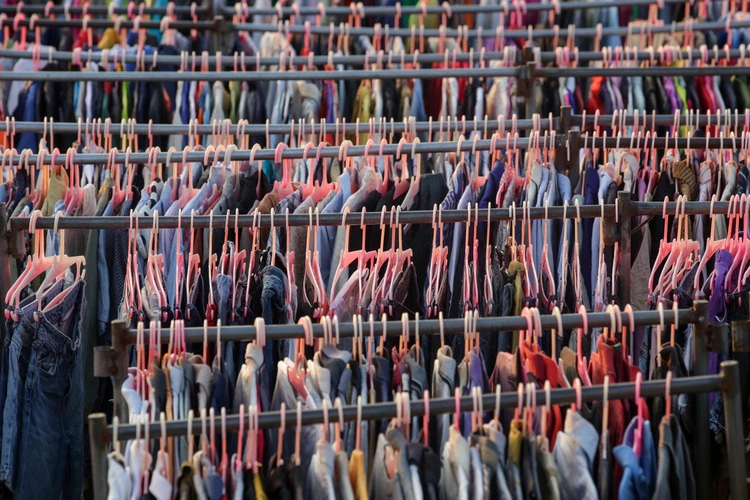
Andrew Brooks considers whether recycling old clothes makes the fashion industry more sustainable or simply fuels even more consumption
Fashion moves at such a rapid rate that new developments in garment production and retail are difficult to map. Fashion is now super-fast. Whereas once the biannual spring/summer and autumn/winter shows were at the forefront of bringing new collections to the high street, now a never-ending transition of clothing designs means that what’s in the window of H&M or Zara today most likely will no longer be available when you return in a few weeks’ time. It’s buy now or miss out.
Online retailers such as ASOS and Shein have pushed even harder on the accelerator, speeding the cycle of manufacturing and consumption. And this is just the shopfront or digital marketplace of the fashion system; behind the point of sale, there are myriad commodity chains that are nigh on impossible to map.
Enjoying this article? Check out our related reads:
The little white label in your new top might read ‘Made in Cambodia’, but that gives only a thumbnail of a complex set of geographical relations. The final garment may have been finished in a factory on the outskirts of Phnom Penh, but it could have been made from cotton grown anywhere from Texas to Uzbekistan, which was then woven in Bangladesh, and sewn with polyester thread made in China, and could follow a pattern produced in Turkey, and be decorated with a logo designed in London, and the retailer might be a Spanish company.
In any meaningful sense, it wasn’t really made in one place. Rather, the Cambodian origin is a useful designation, and bringing the component parts together in
that location makes financial sense because it’s somewhere that is classified as a Least Developed Country and benefits from preferential access to the UK marketplace.

The clothing industry has always exploited differences between places to enhance profitability, and in turn has helped make some regions affluent while impoverishing others. The transatlantic cotton trade was at the forefront of the development of colonial capitalism. At that time merchants took advantage of different economic and environmental conditions to drive down the costs of garment production and increase profitability.
West Africa was depopulated and economically undermined as it provided a source of cheap labour in the brutal form of transatlantic slavery. This was one of the worst chapters of human history, resulting in two million deaths in transit and many more devastating incidents of cruelty.
The savannah climate in the southern reaches of what would become the USA was well suited to growing cotton. Technological developments in northern England sparked the Industrial Revolution, and American fibres were manufactured into textiles and clothing, which were then profitably exported to Britain’s captive markets across the empire.

Back in the present, the latest and most dynamic new development in clothing consumption can be found in the used rather than the new clothing trade. The re-selling of old clothes is increasingly part of something new: Web3, the latest iteration of the internet, which in tandem brings together two opposing trends – an increase in the penetration of decentralised technologies and an enhancement of the concentration of power within a limited number of companies.
Peer-to-peer second- hand retailers, including Depop, eBay and Vinted, have catalysed a boom in used fashion. As a Lithuanian company, Vinted shows the ways in which the geographies of fashion are never static. It has become incredibly popular, with 21 million users worldwide, and is valued at €5 billion. Vinted works because it’s easier to use than eBay and makes selling your old clothes directly to other consumers as frictionless as possible by having no seller fees and using tech to integrate the postal process.
The growth in peer-to-peer trade opens new geographical questions around sustainability. Is this re- selling of fashion beneficial forthe environment? Propagating a system of clothing reuse is a good thing. It’s better for clothes to have a second life and to slow the rate of disposal.
Moreover, in contrast to the international second-hand clothing trade, which sees large exports of unwanted garments flow from Europe and the USA for resale in Africa and Asia, Vinted is centred on selling clothes within national marketplaces, reducing the impact of transport and matching consumers with fashions, rather than dumping unwanted goods from the West on underdeveloped economies.
Conversely, at a broader scale, Vinted could be feeding the beast of overconsumption. Encouraging avid shoppers to have a clear-out and make a few quid in the process may facilitate their addiction for new clothes. Maybe after logging out of Vinted, they go back to the high street or, more likely, open the Shein app. Rather than being a sustainable solution, peer-to- peer selling could simply be a tool that facilitates a wardrobe cleanse and enables ever-greater, faster-faster consumption of new fashion.



